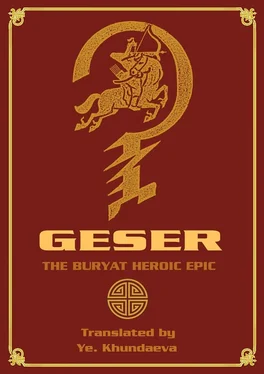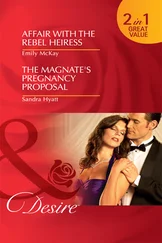Ye. Khundaeva - Geser. The Вuryat heroic epic
Здесь есть возможность читать онлайн «Ye. Khundaeva - Geser. The Вuryat heroic epic» — ознакомительный отрывок электронной книги совершенно бесплатно, а после прочтения отрывка купить полную версию. В некоторых случаях можно слушать аудио, скачать через торрент в формате fb2 и присутствует краткое содержание. ISBN: , Жанр: Языкознание, foreign_language, на английском языке. Описание произведения, (предисловие) а так же отзывы посетителей доступны на портале библиотеки ЛибКат.
- Название:Geser. The Вuryat heroic epic
- Автор:
- Жанр:
- Год:неизвестен
- ISBN:9785448558627
- Рейтинг книги:3 / 5. Голосов: 1
-
Избранное:Добавить в избранное
- Отзывы:
-
Ваша оценка:
- 60
- 1
- 2
- 3
- 4
- 5
Geser. The Вuryat heroic epic: краткое содержание, описание и аннотация
Предлагаем к чтению аннотацию, описание, краткое содержание или предисловие (зависит от того, что написал сам автор книги «Geser. The Вuryat heroic epic»). Если вы не нашли необходимую информацию о книге — напишите в комментариях, мы постараемся отыскать её.
Geser. The Вuryat heroic epic — читать онлайн ознакомительный отрывок
Ниже представлен текст книги, разбитый по страницам. Система сохранения места последней прочитанной страницы, позволяет с удобством читать онлайн бесплатно книгу «Geser. The Вuryat heroic epic», без необходимости каждый раз заново искать на чём Вы остановились. Поставьте закладку, и сможете в любой момент перейти на страницу, на которой закончили чтение.
Интервал:
Закладка:
As a consequence the Buryat tales give the exaggerated grotesque fantastic descriptions of the personages irrespective of their being either positive or negative. Some are horrible, ugly and fearful whereas the others are the ideals of beauty, strength and generosity. The former are quite fear-exciting with the many eyes, many heads, sharp claws and teeth covered with snakes, blowing out flame and sparks. The latter are well-built, strong and slender, handsome and attractive.
The ideas of the heavenly origin of the totemic forefathers of the Buryats as well as the ideas of the spirit-hosts of the localities, the shamans, the epical heroes are related to the archaic cult of the Eternal Blue Sky which is taken to be the highest divinity and the creator of all that is found in the Universe. The highest divinity, the sky or the Heaven (“tengri” in Buryat) is personified in the epic as Khormusta Tengeri or Esege Malan Tengeri. The most archaic cult of the Mother-Earth, the foremother, has the genetic ties with the cult of the World Tree and the World Mountain. It has greatly affected the emergence of the other, not less popular cults, like those of the Fire, the Mountain Caves, the Water, the Genealogical tree. There are the shaman elements and the Buddhist inclusions. Then one can mention the cosmogonic prologue of the epic, the creation of the main hero by the Heavenly Gods who was then sent down to the Earth with the mission of fighting the evil, Geser¢s three celestial sisters, the theme of the cosmic marriage or the motive of being born from a cracked-apart stone. The archetype of the celestial forefather is often connected with the solar motive, e.g. a golden pole or rays of the Sun coming through the upper opening of the yurt are associated with the conception of the son. This all proves that the Buryat people were respectful towards nature, natural objects and natural phenomena.
Geser is both a shaman and a healer. He can control the natural atmospheric phenomena. Geser is one of the sons of Khormusta tengri, residing in the Heavens, the highest sphere of the Universe. When there came the time of trouble and misfortune on the Earth he was chosen to descend to the Middle sphere (the Earth) to struggle against the evil and complete his mission of salvation of the people. He was born on the Earth an ugly child, this is accounted for by the necessity for him to survive, it was kind of protection against the evil forces, the spirits and the like. When he was a child one of his names was Bukhe-Beligte (strong and gifted). Since childhood he was noted for his unusual gifts. He committed good deeds, displaying the magic abilities which helped him in doing good things. When he grows up he turns into a mighty warrior. The three cosmic spheres are in his power. His origin is in the sky, among the divinities, i.e. in the Upper World. He lives on the Earth, in the Middle world. He travels to the Lower world, i.e. the Water kingdom and establishes the ties with its Lord having married his daughter.
Much of what has been mentioned above is in favor of the idea that people in the past were guided by the intuitive, emotional, humane feelings. In the past the folklore, the rites and the creative arts made a significant contribution to the psycho-emotional state of the members of the communities. One can also draw the conclusion that all the phenomena somewhat “magic” in their essence are closely connected with, affected and inspired by Nature and the way the people treat it.
The golden proportion in the Buryat Geseriade
The golden section or the golden proportion is the division of something into two parts so that the relation of the bigger or longer part towards the smaller or shorter part equals the relation of the whole towards the bigger part. The author of the principle of the golden section is Leonardo de Vinci (1451—1519). Roughly speaking, the relation 2 to 3, 4 to 6, 6 to 10 is best. For instance, the sculpture looks well if the pedestal is 3 parts and the figure is 2 parts. The monument “Hospitable Buryatiya” in Ulan-Ude is structured in accordance with the golden proportion, that is, the lower part (the pedestal) is approximately 3 parts and the statue itself is 2 parts. The proportion is 2 to 3, which makes the statue look quite impressive and majestic. The figures and objects on the bas-relief of the building of the Buryat Drama theatre in Ulan-Ude are also structured in relation of about 2 to 3 (from left to right). It looks nice because it is comfortable for the perception by eye-sight. It helps to comfortably visualize something because it observes the law of the golden proportion. Everything in nature obeys that law: the structure of the pine tree cones, algae, mollusk or the ear and the eye, the pulse of the heart, the brain biorhythm, etc. It is also observed in structuring the poems, the pieces of music and painting.
One can briefly dwell on the law of the golden section which is based on the natural phenomena and is also marked in the Buryat epic. Man gradually came to the notion of the golden section as an expression of a certain harmony after having been observing for thousands of years the presence of some adequacy and order in the objects, processes and the interactions observed in the material world.
The golden section or the golden proportion divides something into the two parts so that the relation of the bigger or longer part towards the smaller or shorter one equals the relation of the whole towards the bigger part. This principle well coordinates the parts of the whole unit, it’s kind of the dynamic symmetry. This is found in the human organism, in the gene system, in the build-up of the ear, in the interlocation of the rod of retina of the eye apple, in the pulsation of the heart muscle, in the symmetrical biorhythms and the neuro-physiological structure of the brain, the proportion of the body and organs.
The key to its understanding might be found in the specificity of the mental activity of the human brain as an invariant of the betta-wave emerging during mental activity. Let’s recollect in this respect the ancient pyramids where one can observe the same phenomenon. This principle became an academic canon in architecture when it was understood that it was good to erect the building, the compositional properties of which should be invariant to the biorhythmic properties of man.
This principle is presented in painting too as it has been mentioned above. Its simplified variant is division of the canvas in proportion of 6 to 4 or 3 to 2 where the main figure should be located not strictly in the center. One can divide the picture into 5 parts then the golden section will be found in 3 to 2 relation. The main object is located in the point of the intersection. The visual and notional or semantic center may be located either in the right, left or the lower, upper part of the picture. This is prompted by the lay-out or the structure of the eye, the specificity of the activity of the brain and the regularities of the visual perception. Where there is the motion, growth and development, there is the principle discussed. In botany, biology this might be observed in the location of the scales in the cones of pine-trees.
It can be found in poetry as it has been mentioned above. Take, for instance, Pushkin’s novel “Eugene Onegin”. Its structure is based on the closeness to Fibonacci’s numbers: 8, 13, 55. Eugene’s letter to Tatyana breaks the last chapter into 2 parts: 32 and 19 verses. Let’s divide 32 by 19, we’ll get 1, 68 which is the criterion of the harmonic build-up in which the growth of the emotional strain is longer than the culmination and the fall.
In the compositional build-up of many musical works there is the highest point of culmination which is seldom situated in the central part of the work. In many eight-bar melodies of many composers like Skryabin, for one, the culmination is in the point of the golden section.
Читать дальшеИнтервал:
Закладка:
Похожие книги на «Geser. The Вuryat heroic epic»
Представляем Вашему вниманию похожие книги на «Geser. The Вuryat heroic epic» списком для выбора. Мы отобрали схожую по названию и смыслу литературу в надежде предоставить читателям больше вариантов отыскать новые, интересные, ещё непрочитанные произведения.
Обсуждение, отзывы о книге «Geser. The Вuryat heroic epic» и просто собственные мнения читателей. Оставьте ваши комментарии, напишите, что Вы думаете о произведении, его смысле или главных героях. Укажите что конкретно понравилось, а что нет, и почему Вы так считаете.











